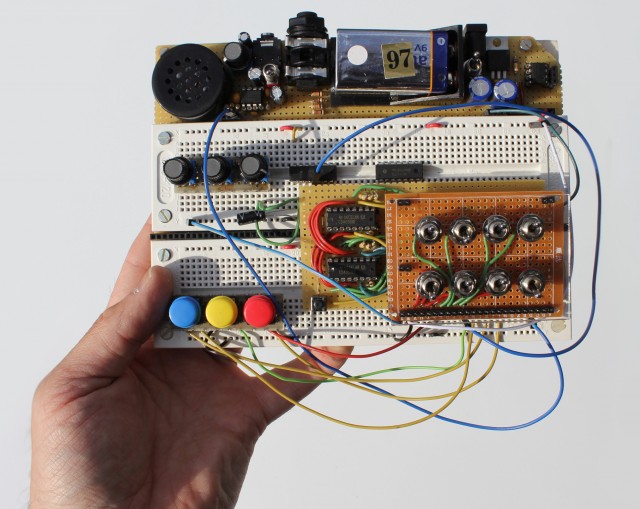Pete Edwards and Phillip Stearns are developing a new breadboard-based modular synthesizer.
The new system is designed for maximal scalability of size, quality and hardware format. This will allow experimenters to quickly and cheaply connect circuit boards with simple jumper wires, but also allow for adapting the circuits to be housed in rugged systems for live performance.
Here’s what they have to say about the new breadboard modular synthesizer design:
This system is based on minimizing the differences in the input and output ‘languages’ used in various musical electronic formats. This means finding a way to allow free communication between logic, analog and eventually digital electronics.
We are working to achieve this by finding a middle ground between these mediums where signal format and amplitude can be shared freely with minimal need for translators and adaptors.
Our proof of concept models have shown that unhindered communication between binary logic and variable analog systems renders wildly adventurous possibilities and a unique musical character.
This video demonstrates some prototype modules being developed for a larger breadboard based modular synth system:
The current collection of modules demonstrated here were developed and designed by Phillip Stearns using a stackable, header-based form factor designed by Pete Edwards. Each module features CMOS chips configured into powerful core multipurpose functions.
The current lineup of modules includes:
- The Shifter: A complex signal generator that utilizes an 8-bit linear feedback shift register.
- Divide by 2 by 2 by 2 by 2…: a frequency divider that produces 12 sub octaves with three programmable 1 of 8 outputs.
- Divide by 3 – 10: A frequency divider that produces subharmonics
- The Digitizer: A real-time 3-bit ADC
- The Rhythm Brain: Three synchronized, independently programmable binary rate multipliers.
Future plans for the project include the development of VCO, VCA, and VCF modules that operate on 5 volts, releasing schematics and system specifications to the public and production of low profile breadboard compatible modules in kit and pre-fabricated form with options for either through hole or smd components.
See the STEIM (the STudio for Electro-Instrumental Music) site for details.


Nerdgasm. This is the synth equivalent of Amy Pond wearing nothing but geek glasses and a Linux t-shirt. I got so excited I had to use my inhaler – twice!
I wish I could know how to use this weird stuff, seems a bit complicated but i love to see these guys workin on that.
Oh, I get it! A really fiddly Lunetta with a tendency to crash.
crash? what makes you think that? It will NEVER crash. The point is quite the opposite. It is a system that invites exploration by minimizing nearly all potential for malfunction and crashing.
For the longest time, I’ve wanted to build a modular system but couldn’t really justify the cost. And for the longest time I wondered why I couldn’t find any simple DYI solutions like this. All of sudden, here it is! Can’t wait for the blueprints; my soldering iron is so lonely
It looks atrocious . And there is no reason for the breadboard.
Hmm. What is their agenda..? Are they going to sell modules, share schematics or what? Because the stuff seen in this video is pretty basic Lunetta / CMOS stuff that you can build from cheap off the shelf components anyway. Things might get more interesting though, if they’re going to make real VCO’s and VCF’s as they promised (with real I mean standard volt per octave CV:s). Great Lunetta database here: http://electro-music.com/forum/viewtopic.php?t=42772
Hey Ville. Good question! I absolutely LOVE the lunetta movement. It takes all the tedium and need for precision out of analog synthesis and gets you straight to results with minimal work. My goal is to create a central platform that allows people to combine lunetta style logic synthesis with analog function blocks, microcontroller based modules and…. whatever else comes next. This is a prototype of a design approach. We simply designed some logic blocks to play with but these are just examples of what CAN be done.
And yes I plan on designing analog modules and yes I will make EVERYTHING open source.
So does this sound better than a VSTi put through VST tube processing, VST EQ, and a VST compressor?
HEY! I know that phillip guy! I took a glitch art class from him!